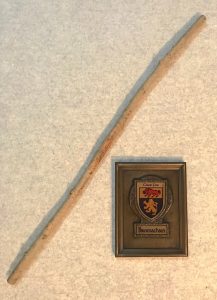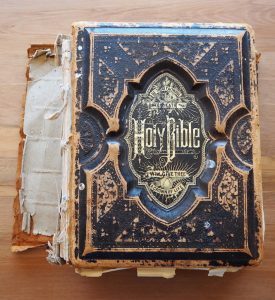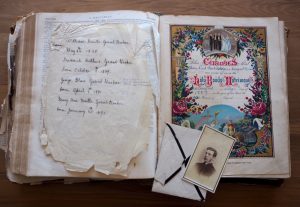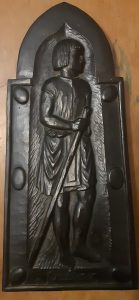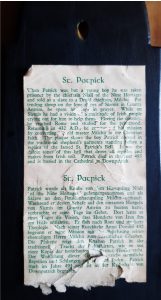Brosnahan Family Plaque and Wooden Staff
Date of Creation: 2013
Arrival in Dunedin: 2013
Materials: Wood (ash). Cold caste bronze, brass and enamel
Description:
- Short wooden (ash) staff, the symbol of authority of the Ceann Fine.
- 860mm [l] x approximately 20mm [circumference]
- Cold cast bronze plaque, brass and enamel, black felt backing
- 180mm [w] x 235mm [h] x 18mm [d]
Researcher: Jack Brosnahan
History:
In July 2013 there was a World Gathering of Clan Brosnan at Castleisland, County Kerry, Ireland. Seán Brosnahan, a Dunedin-based historian whose ancestors migrated from Kerry to New Zealand in the 1860s and 1870s, attended this gathering along with his father and several cousins. He was there honoured to be appointed to the role of Ceann Fine (clan chieftain) of the Brosnan clan worldwide, and as a symbolic representation of this office was presented with a plaque and wooden staff (ash).
Significance:
The plaque bears the coat of arms of Clan Brosnan, featuring the blazon of a gold lion rampant upon a blue field, and in chief a red boar upon a gold field. Ash trees feature strongly in Irish mythology and folklore, and were historically considered to be sacred (along with oak and hawthorn trees).
For Seán Brosnahan, these objects are a physical representation of his family’s continued connection to Ireland and the important place of their Irish identity. The Brosnahan diaspora in New Zealand continue to think of themselves as “being from Ireland and Kerry, but also from New Zealand.” These two identities continue to coexist and interact 150 years or more since the family settled in New Zealand.
Grant-Ussher Family Bible 1881
Date of Creation: 1881
Arrival in Dunedin: December 1881
Materials: Calf leather, decorative gold, paper
Measurements: 32cm (l) x 26cm (w) x 12cm (h)
Description:
Church of Ireland Old and New Testament Holy Bible, blind tooled, raised cover with gilding, full and partial page black/white and colour illustrations.
Researcher: Meghan Kruskopf
History:
This Holy Bible was brought to Dunedin in 1881 by William Grant-Ussher on the ship Oamaru, from Co. Cork, Ireland. It is assumed to have been given to Grant-Ussher by his family as he was the only son, though the reason for his migration to New Zealand is unknown. Grant-Ussher left behind wealth and several estates in Ireland but ensured the safe journey of his Church of Ireland bible, which includes family births and deaths, and photographs taken at studios in Dublin. The family pages have continued to be filled in over the generations.
Significance:
Religion was a significant part of life in Ireland, and the family bible was central to this. As well as providing a connection to religion, this also played a role in connecting Grant-Ussher to home, with the inclusion of family details and photographs. Family bibles such as this were important to many migrant families for recording family members and significant dates. As well as being a practical item of worship, this family bible was also a sentimental reminder of who and where he left behind, and remains in the family still, continuing this connection to Ireland, from Dunedin.
St Patrick Icon
Date of Creation: Unknown
Arrival in Dunedin: Approximately 1920s
Materials: Wood, painted black
Measurements: 255mm (h) x 120mm (w)
Researcher: Billy La Roche-Matheson
History:
Thomas Fahey brought this carved wooden icon of Saint Patrick to New Zealand from Galway, Ireland, where he was born. He brought the object in the 1920s when his family migrated here.
This image features a depiction of Saint Patrick. Saint Patrick is wearing simple shepherds’ clothing as mentioned on the back of the plaque. He is also barefoot and holding a walking stick. The background is decorated in such a way as to highlight the central and proud figure of Saint Patrick. The back of the plaque is bare except for the old paper stuck to it. On the paper is some writing in English and German which offers a brief description of the life of Saint Patrick and his vision that drove him to the church.
Significance:
Depictions of Saint Patrick, the patron saint of Ireland, held specific importance for Irish migrants, as he symbolises their cultural and religious identities. For an Irish Catholic priest in New Zealand, such as Thomas Fahey, such iconography would be especially meaningful.
Waterford Crystal Set
Arrival in Dunedin: June 1974
Materials: Crystal
Description: Part of 32 piece set including decanter and wine glasses
Researcher: Luke Henderson
History:
This Waterford Crystal set was brought to Dunedin in 1974 when Brian and Joan Rea fled the violence of Belfast during ‘the Troubles’. It was given to Brian as a parting gift from the young men of the football team that he coached, the group most likely to become victims of the violence. While rushing to leave Belfast, the Reas did not have time to research New Zealand, resulting in them giving their warm clothes away before moving to Dunedin in mid June (winter).
Luckily, the Catholic organisation St Vincent de Paul gave the Rea family and others like them much needed assistance when migrating from Northern Ireland to Dunedin. They helped the Reas find a home to rent, a job, and provided them with second hand furniture and clothing until they got on their feet.
Significance:
During the 1970s Belfast was caught up in the political violence, known as ‘the Troubles’, over the question of whether Northern Ireland should remain in the United Kingdom.
Brian and Joan left war torn Belfast for Dunedin with two small children and few possessions, money or personal contacts. This Waterford crystal set was the only luxury item they were able to bring as a reminder of their ‘home’.

